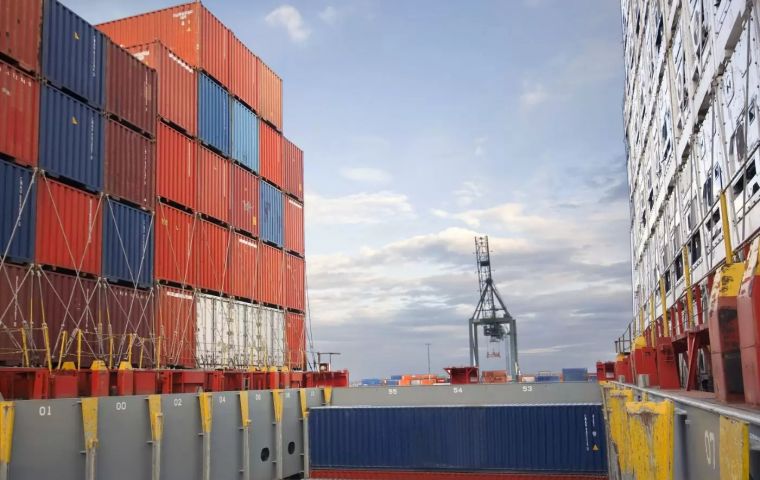MercoPress. South Atlantic News Agency
Brazil sees bilateral trade with Argentina falling in 2024
 Bilateral trade Argentina/Brazil reached US$ 27 billion in eleven months of 2023, with Brazilian exports totaling US$ 17bn, and Argentina US$ 11bn.
Bilateral trade Argentina/Brazil reached US$ 27 billion in eleven months of 2023, with Brazilian exports totaling US$ 17bn, and Argentina US$ 11bn. Brazil's main financial and business publication, Valor Economico is forecasting that bilateral trade with Argentina is expected to fall in 2024, based on the recent measures announced by the government of president Javier Milei. In the eleven months of 2023, bilateral trade between Argentina and Brazil reached US$ 27 billion, with Brazilian exports totaling US$ 17bn, and Argentina US$ 11bn.
Valor Economico points out to three main issues, the devaluation of the Argentine Peso against the US dollar, with the exchange rate zooming from 400 to 800 Pesos. Secondly an increase in the tax on dollar purchases for imports even at the new exchange rate which has more than doubled from 7,5% to 17,5%. Finally the additional 15% export tax becomes extensive to all produce, when previously only agriculture and mining were subject to the burden.
However, ”these are necessary macroeconomic measures, but they will negatively impact on bilateral trade,” said Welber Barral, Brazil’s former foreign trade secretary and a founding partner of BMJ Consultores e Associados. Mr. Barral has been in Buenos Aires since July, where his consultancy firm maintains an office and supports Brazilian and multinational companies operating in Argentina.
Nevertheless among the unresolved issues is the dilemma faced by private-sector companies unable to access dollars at the official exchange rate for import payments. This has resulted in a debt of approximately US$ 45bn, and with an empty Central Bank, which only has negative international hard currency reserves, depleted by theprevious government of the Kirchners.
On the bright side is the commitment to streamline the import license process, which had become a significant challenge for many companies in Argentina. However, Mr. Barral underlines concern over the increased taxes on exports and, particularly, the higher taxes on dollar purchases for imports. He believes these measures will raise import costs and negatively impact Brazilian sales, effectively acting like a tariff.
Argentine President Milei has said that these measures are intended to be temporary, lasting until at least throughout the next twelve months, and that following a period of adjustment, the economy will become more balanced and with more available US dollars.
In the meantime, the government and economists anticipate a recession, rising inflation, increased poverty, the potential for social unrest and for.president Milei's honeymoon turning souar.
Livio Ribeiro, an associate researcher at the Brazilian Institute of Economics of the Getúlio Vargas Foundation (FGV/Ibre) and a partner at the BRCG consultancy firm, asserts that the decline in Brazilian and other countries’ exports to Argentina will not primarily result from the fiscal front.
“The issue is the lack of demand from Argentina. The fact that it becomes more expensive for Argentines is less significant; the main concern is the absence of demand,” he explained. Argentina is a significant importer of car parts and automobiles from Brazil, along with iron ore and electricity. Due to a historic drought, Argentina once a leading exporter of soy oil and other derivates, has been forced to import large volumes of soy since last year.
“Demand is set to decline,” stated Federico Servideo, president of the Argentine-Brazilian Chamber of Commerce in São Paulo. Despite this downturn, he identifies opportunities for Brazilian companies to invest in Argentina, particularly in the energy, farm, mining, finance, and retail sectors.
In discussing devaluation, Mr. Servideo notes that “the real dollar” had already been hovering around 800 pesos per dollar for some time, suggesting that more competitive exporting companies are likely to benefit. He endorses the current approach: “The direction is correct. The key is further integrating Argentina into the global market, normalizing the exchange rate, and fulfilling commitments. The major concern, however, is how this will be implemented and whether it will have political sustainability.”




Top Comments
Disclaimer & comment rules-

Read all commentsWell yeah, Supply and Demand, right? What's the problem, again?
Dec 24th, 2023 - 03:49 am +1Commenting for this story is now closed.
If you have a Facebook account, become a fan and comment on our Facebook Page!